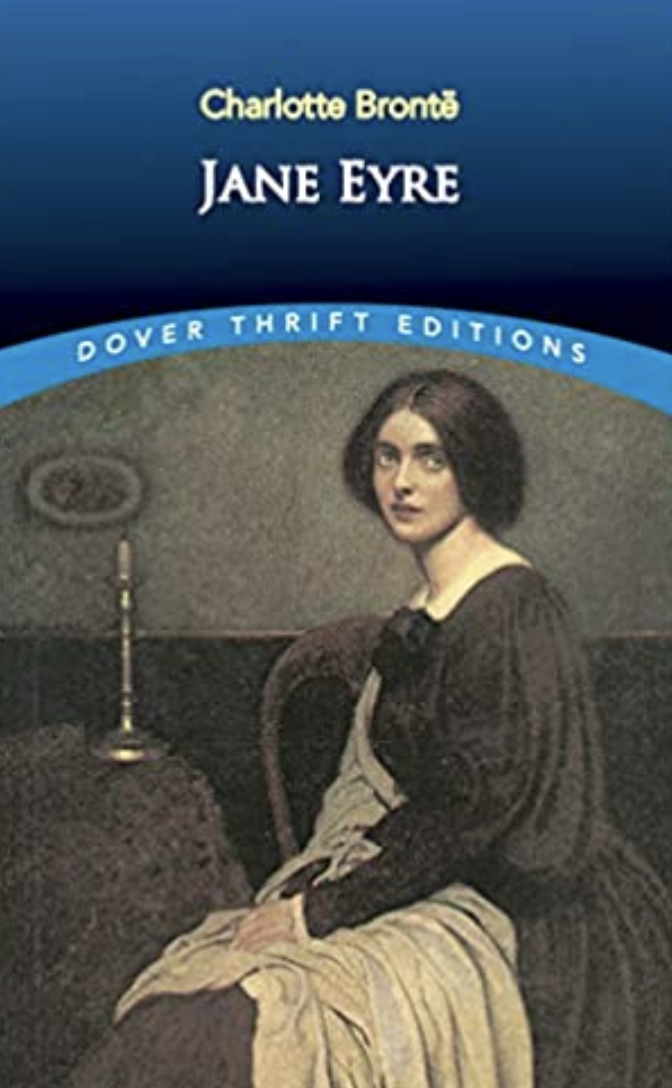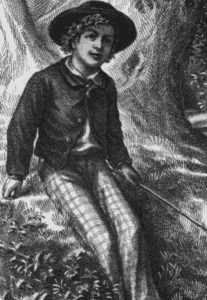Author: Charlotte Brontë, a nineteenth-century English novelist and poet.
Jane Eyre is both the first-person narrator and the spirited protagonist of this nineteenth-century iconic novel. It is the story of Jane’s trials and tribulations as a young orphan living with her aunt Sarah Reed and her children, and later at Lowood School. When she grows up, the story describes her relationship with her employer Edward Rochester, and the unusual household of Thornfield Hall, where she is employed as a governess to Rochester’s ward Adèle.
Jane was orphaned at an early age when her clergyman father and mother died of typhus fever. She is being raised at Gateshead by her strict and unsympathetic aunt. Her cousins, John, Eliza, and Georgina, bullies and ill-treat her. Jane is not docile by nature and does not meekly endure the bullying. This causes Aunt Sarah to lock her up in the so-called ‘red room’ one day to punish her. This is the very room in which her uncle had died, and Jane imagines that she sees her uncle’s ghost. After this, she is sent to Lowood School, a long distance away from Gateshead.
The school is not much of an improvement, with miserable living conditions, poor quality of food, and a self-serving disciplinarian, Mr. Brocklehurst, as the headmaster. At Gateshead, only the servant Bessie was kind to Jane. At Lowood, however, she finds a good friend in Helen Burns, a fellow student; and a gentle mentor in Maria Temple, the superintendent. Jane develops patience and fortitude in Helen’s company. One of the teachers constantly picked on Helen, but Helen never lost her temper. With Helen’s example, and with Miss Temple’s encouragement, Jane is able to concentrate on her studies, in spite of Mr. Brocklehurst denigrating her before the others.
Unfortunately, Jane loses her first real friend all too soon. Helen dies of consumption in the spring when there is a typhus fever outbreak at Lowood. This event brings the school’s terrible conditions to the attention of the benefactors. Brocklehurst is accused of embezzlement and leaves. Thereafter, Miss Temple is placed at the helm, and the school becomes a worthy institution of excellence. Jane completes her education and stays on as a teacher until Miss Temple marries and leaves the school. At this juncture, Jane looks for a change and takes up the position at Thornfield Hall.
Jane gets to meet her employer Rochester a long time after coming to Thornfield. He seems to be away a lot. The enigmatic but elegant Rochester fascinates her, and soon he comes to care for her as well. She saves him from a fire in his bedroom one night, apparently caused by the seamstress Grace Poole who lives in the attic. Jane had heard weird laughter from the attic but was not convinced by the explanations proffered by Rochester and his housekeeper Mrs. Fairfax.
Rochester tells Jane that his ward is the daughter of his former French lover Céline. He also tells her he wishes to rectify his earlier mistakes by marrying Blanche Ingram, a beautiful young woman he brings to Thornfield Hall. In spite of this, Jane continues to harbor the hope of winning his heart. Another guest, Richard Mason, appears during this time. Rochester seems aghast at his arrival. Later that night, Mason is attacked and severely injured in the attic, allegedly by the mysterious female occupant of the attic. Jane hears Rochester tell the doctor called to tend to Mason that he will look after her. Jane is not entirely sure whom Rochester is referring to.
Jane returns to Gateshead when her aunt is on her deathbed. Earlier, Bessie had visited Jane at Lowood and informed her that a certain John Eyre had inquired about her at Gateshead. Now Jane receives her Uncle John’s letter to her, which Mrs. Reed had hidden for three years. Moreover, she had told John Eyre that Jane had died of typhus fever during the epidemic at school. In the letter, her uncle expressed his wish to leave his wealth to Jane.
After her aunt’s death, Jane returned to Thornfield again. Rochester now asked her to marry him having realized that Blanche was only marrying him for money, while Jane truly loved him. Jane accepted the proposal and wrote to John Eyre to find out whether she could get her inheritance before her marriage. The marriage ultimately does not take place due to a dramatic turn of events. The church ceremony is interrupted by a local attorney called Briggs, who claims that Rochester is already married. Jane’s dreams are shattered by Rochester’s deception.
The mystery of the woman in the attic is finally solved. She is Richard Mason’s sister Bertha, whom Rochester had married fifteen years earlier, and who is now a raving lunatic cared for by Grace Poole. Jane had a glimpse of her the night before her wedding when Bertha entered her room and tore Jane’s wedding veil. The match with the wealthy Masons was arranged by Rochester’s father without knowing that the family had a history of insanity. Jane rejects Rochester’s suggestion of living together unwed in France and leaves Thornfield Hall hurriedly in distress.
In her distraught state of mind, Jane forgets to take her belongings with her when she leaves the coach at Whitecross. A period of penury and homelessness follows, which ends only when she finds refuge at the home of St. John Rivers, named Moor House. However, she calls herself Jane Elliot there. St. John is the minister of the parish and lives with his sisters Diana and Mary, with whom Jane develops a congenial attachment. With the help of St. John, she finds teaching work at a school in neighboring Morton.
By a propitious turn of events, St. John finds Jane’s real name in her drawing book and realizes they are cousins. He learns Mr. Briggs is looking for Jane, who has been left a fortune by the late John Eyre. St. John reveals their relationship to Jane, and Jane shares her wealth with the Rivers siblings, who were not well off. She rejects St. John’s offer to marry him and sail with him to India, where he was going as a missionary when she hears Rochester’s voice calling her in her mind.
This prompts her to return to Thornfield Hall, which lies in ruins before her. The village innkeeper informs her that Bertha had burnt it down and died in the fire, while Rochester lost a hand and his sight trying to save her. Jane is reconciled with him at Ferndean estate close by and learns that Rochester had actually called out her name aloud and heard her replying she was coming to him.
The narrative ends on a happy note with Jane informing the reader of their ten years of wedded bliss. Rochester had also recovered the sight in one eye by the time their son was born.




